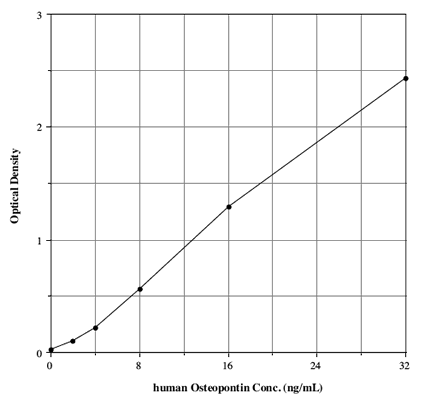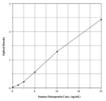Replaces Prod. #: ADI-960-142
- Tested - thoroughly validated in plasma, urine, and milk
- Fast - results in just 3 hours from up to 41 samples in duplicate
- Trusted - data correlating assay results to cancer patient survival published in peer-reviewed journals
- Reliable - reproducible results day-after-day and lot-after-lot
- Convenient - ready-to-use pre-coated plates and liquid color-coded reagents reduce errors
The Osteopontin (human), EIA kit is a colorimetric immunometric enzyme immunoassay kit with results in 3 hours. Absorbance is read at 405 nm. Ready-to-use liquid color-coded reagents reduce error. Excellent publications in peer-reviewed publications demonstrate the utility and consistency of this kit developed with highly cited double monoclonal antibodies.
Please mouse over
Product Details
| Alternative Name: | OPN, SPP1, Secreted phosphoprotein 1, Bone sialoprotein 1 |
| |
| Sensitivity: | 0.110 ng/ml (range 2 - 32 ng/ml) |
| |
| Assay Time: | 3 hours |
| |
| Applications: | ELISA, Colorimetric detection
|
| |
| Application Notes: | For the quantitative determination of human Osteopontin in culture supernatants, milk, plasma, and urine. Cited sample type includes serum. |
| |
| Wavelength: | 405 nm |
| |
| Species reactivity: | Human
|
| |
| Crossreactivity: | Human Osteopontin (100%), native human Osteopontin (111%) and <0.1%: native bovine Osteopontin, recombinant mouse Osteopontin |
| |
| Use/Stability: | Store all components at +4°C, except standard and conjugate at -20°C. |
| |
| Shipping: | Dry Ice and Blue Ice |
| |
| Contents: | Microtiter plate, Conjugate, Antibody, Assay buffer 10 concentrate, Wash buffer concentrate, Standard, pNpp Substrate, Stop solution |
| |
| Scientific Background: | Osteopontin (OPN) is an acidic extracellular matrix cell adhesion protein that is relatively abundant not only in bone matrix, plasma, urine, and milk, but is also found in malignant and atherogenic tissues. Phosphorylation, glycosylation and calcium modifications allow intact and fragmented Osteopontin to direct a variety of diverse responses including tissue remodeling, inflammation and cell survival. Plasma Osteopontin has been shown to be a positive indicator of colon and lung cancers as well as metastatic carcinomas. The notable presence of Osteopontin in a variety of tumors is strongly correlated to pathological stage, suggesting its critical role in tumor invasiveness, progression and metastasis. In addition, Osteopontin inhibits inducible nitric oxide synthase activity, thereby protecting tumor cells from NO-mediated macrophage cytotoxic attack. Osteopontin is found in atherosclerotic plaques and may drive a number of diabetic vascular pathologies. |
| |
| UniProt ID: | P10451 |
| |
| Regulatory Status: | RUO - Research Use Only |
| |
| Compatibility: | This product is compatible with the Absorbance 96 Plate Reader.
 |
| |
Product Literature References
Evaluation of diagnostic and prognostic candidate biomarkers in drug-induced liver injury vs. other forms of acute liver damage: A.C. Sánchez, et al.; Br J Clin Pharmacol
89, 2497 (2023),
Abstract;
Isoform-specific promotion of breast cancer tumorigenicity by TBX3 involves induction of angiogenesis: M. Krstic, et al.; Lab. Invest.
100, 400 (2020),
Abstract;
Full Text
Role of osteopontin as a predictive biomarker for anti-EGFR therapy in triple-negative breast cancer: P.H. Anborgh, et al.; Expert Opin. Ther. Targets
22, 727 (2018),
Application(s): ELISA using culture supernatants,
Abstract;
The embryonic type of SPP1 transcriptional regulation is re-activated in glioblastoma: M. Kijewska, et al.; Oncotarget
8, 16340 (2017),
Abstract;
Full Text
Decreased Cathepsin K Plasma Level may Reflect an Association of Osteopoenia/osteoporosis with Coronary Atherosclerosis and Coronary Artery Calcification in Male Patients with Stable Angina: O.L. Barbarash, et al.; Heart Lung Circ.
25, 691 (2016),
Application(s): Osteopontin levels measured in plasma samples,
Abstract;
Pleural fluid osteopontin, vascular endothelial growth factor, and urokinase-type plasminogen activator levels as predictors of pleurodesis outcome and prognosticators in patients with malignant pleural effusion: a prospective cohort study: L.H. Hsu, et al.; BMC Cancer
16, 463 (2016),
Application(s): Measurement of pleural fluid OPN, VEGF, uPA, and PAI-1 concentrations,
Abstract;
Full Text
Role of plasma osteopontin as a biomarker in locally advanced breast cancer: P.H. Anborgh, et al.; Am. J. Transl. Res.
7, 723 (2015),
Application(s): ELISA using human plasma,
Abstract;
Full Text
Assessment of osteopontin in early breast cancer: correlative study in a randomised clinical trial: V.H. Bramwell, et al.; Breast Cancer Res.
16, R8 (2014),
Application(s): ELISA using human plasma,
Abstract;
Evaluation of circulating osteopontin levels in an unselected cohort of patients with multiple sclerosis: relevance for biomarker development: P. Kivisäkk, et al.; Mult. Scler.
20, 438 (2014),
Application(s): ELISA using human plasma,
Abstract;
Osteopontin and galectin-3 predict the risk of ventricular tachycardia and fibrillation in heart failure patients with implantable defibrillators: P. Francia, et al.; J. Cardiovasc. Electrophysiol.
25, 609 (2014),
Application(s): ELISA using human plasma,
Abstract;
Osteopontin as a marker of weight loss in lung cancer: F. Karadag, et al.; Scand. J. Clin. Lab. Invest.
71, 690 (2011),
Application(s): ELISA using human serum,
Abstract;
Water solution of onion crude powder inhibits RANKL-induced osteoclastogenesis through ERK, p38 and NF-κB pathways: R. Yang, et al. ; Osteoporos. Int.
20, 93 (2009),
Application(s): EIA using human culture supernatants,
Abstract;
Related Products













